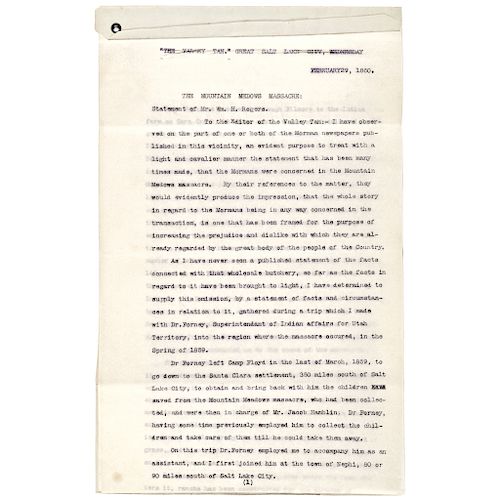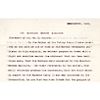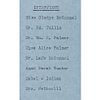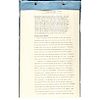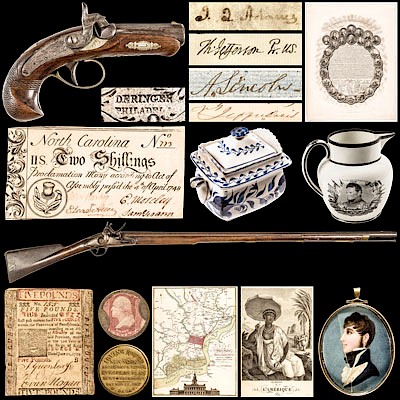1857 MORMONS, Mountain Meadows Massacre Firsthand Interview Important Documents
Lot 66
Categories
Estimate:
$5,000 - $6,000
Absentee vs Live bid
Two ways to bid:
- Leave a max absentee bid and the platform will bid on your behalf up to your maximum bid during the live auction.
- Bid live during the auction and your bids will be submitted real-time to the auctioneer.
Bid Increments
| Price | Bid Increment |
|---|---|
| $0 | $10 |
| $200 | $20 |
| $300 | $25 |
| $500 | $50 |
| $1,000 | $100 |
| $2,000 | $200 |
| $3,000 | $250 |
| $5,000 | $500 |
| $10,000 | $1,000 |
| $20,000 | $2,000 |
| $30,000 | $2,500 |
| $50,000 | $5,000 |
| $100,000 | $10,000 |
| $200,000 | $20,000 |
| $300,000 | $25,000 |
| $500,000 | $50,000 |
About Auction
By Early American History Auctions
Oct 19, 2019
Set Reminder
2019-10-19 12:00:00
2019-10-19 12:00:00
America/New_York
Bidsquare
Bidsquare : Historic Autographs-Currency-Political-Americana-Militaria-Guns
https://www.bidsquare.com/auctions/early-american-history-auctions/historic-autographs-currency-political-americana-militaria-guns-4513
326 Lots of Rare, Historic Autographs, Americana, Civil War Era, George Washington, Abraham Lincoln, Black History, Revolutionary War Era, Colonial America, Federal Period, War of 1812, Colonial Currency, Indian Peace Medals & more... Early American History Auctions auctions@earlyamerican.com
326 Lots of Rare, Historic Autographs, Americana, Civil War Era, George Washington, Abraham Lincoln, Black History, Revolutionary War Era, Colonial America, Federal Period, War of 1812, Colonial Currency, Indian Peace Medals & more... Early American History Auctions auctions@earlyamerican.com
- Lot Description
Autographs
1857 Mormon "Mountain Meadows Massacre" Report
(MORMONS). Lot of Two (2) Historic Typed Documents. February 29, 1860-Dated, Post 1857 Mormon "Mountain Meadows Massacre" Period Investigation Document, plus a Later Firsthand Interview conducted in 1940.
This important historical content lot features Two Original Typed Manuscripts, one circa 1860 and the other being much later, circa 1940. These two documents are a record and Interview Transcripts and a Statement of an investigator of the September 11, 1857 "Mountain Meadows Massacre" of Arkansas emigrants to Utah Territory by Mormon militia. These original documents recount the Firsthand Recollections of Gladys McConnel (whose great-grandfather and great-uncle lived in Cedar City, Utah), Mabel (the daughter of Chief Kanosh of the Paiute Indians), Mrs. Wetherill (an anthropologist who was adopted by the Navajo and allowed to witness sacred ceremonies), and others who were familiar with that period of Mormon history in Utah.
This approximately 50 page, measuring 14" x 9" Legal Size Typed Document is rivet bound at its top margin, having a light-blue paper cover and text detailing the "Massacre" and subsequent concerns. In part, "Miss McConnel was born and raised in Cedar City. Her Great Grandfather, Jehial McConnel was one of the first settlers in Parowan, who built the first house in Iron County... Miss McConnel has made a study of Southern Utah history and has compiled many of the stories told to her by the old people down there..." McConnel further provides great background information, also stating, in part:
"It is my belief, from what I have been able to learn, that Isaac Haight was at the head of the entire Massacre. Haight was the head of the militia in Cedar City... It is absolutely correct that the 'white men' from Cedar City and the other towns, who joined in the Massacre, were dressed as Indians and painted as Indians... It is not likely that the true story of the Mountain Meadow Massacre will ever be know, because after the Massacre, all of those who had participated in it were so terrified that they swore themselves to ever-lasting secrecy... There were plenty of Indians who also joined with the whites in the Massacre.... The thing that was so disgraceful about the whole proceedings was that the white flag of truce was accepted until the Mormons and the Indians could take away the firearms of the emigrants, separate the men, women and children and get them out of their camp... the entire group old enough to talk and understand was killed..."
The Second Manuscript has 19 pages, being a Typed Statement, submitted in February 29, 1860 by William H. Rogers to a Great Salt Lake City newspaper titled, "The Valley Tan," explaining his investigation of the "Mountain Meadows Massacre." This Document measuring 12" x 8 being a lightly folded, carbon copy on onionskin paper, which also recounts the investigation soon after the Massacre. It reads, in part:
"Bishop Lee told the emigrants that the Indians had gone off over the hills, and that if they would lay down their arms and give up their property, he and his party would conduct them back to Cedar City... The emigrants, trusting to Lee's honor and to the sincerity of his statement, consented to the terms... After they had proceeded about a mile on their way, on a signal given by Bishop Higby,... the slaughter began. The men were mostly killed or shot down at the first fire and the women and children who immediately fled in different directions, were quickly pursued and dispatched..."
Both Typed Documents are crisp and clean and exhibit trivial wear on the covers and edges, while the black and purple typed pages are sharp, crisp and fully legible. There is a great wealth of knowledge here about the Massacre itself, the Mormon settlements and the Native American Paiute Indians of the region. This appears as highly important, valuable original period documentation about the infamous "Mountain Meadows Massacre." (2 items).
The "Mountain Meadows Massacre" was a series of attacks on the Baker-Fancher emigrant wagon train, at Mountain Meadows in southern Utah. The attacks culminated on September 11, 1857 with the mass slaughter of the emigrant party by Mormons (members of The Church of Jesus Christ of Latter-day Saints or LDS Church) in the Iron County district of the Utah Territorial Militia and some local Native Americans.
The wagon train, composed almost entirely of families from Arkansas, was bound for California on a route that passed through the Utah Territory during a turbulent period later known as the Utah War. After arriving in Salt Lake City, the Baker-Fancher party made their way south, eventually stopping to rest at Mountain Meadows. While the emigrants were camped in the meadow, nearby militia leaders including Isaac C. Haight and John D. Lee made plans to attack the wagon train. Intending to give the appearance of Native American aggression, their plan was to arm some Southern Paiute Native Americans and persuade them to join with a larger party of militiamen, disguised as Native Americans, in an attack.
During the initial assault on the wagon train, the emigrants fought back and a five-day siege ensued. Eventually fear spread among the militia's leaders that some emigrants had caught sight of white men, and had probably discovered who their attackers really were. This resulted in an order by militia commander William H. Dame for the emigrants' annihilation. Running low on water and provisions, the emigrants allowed a party of militiamen to enter their camp, who assured them of their safety and escorted them out of their hasty fortification.
After walking a distance from the camp, the militiamen, with the help of auxiliary forces hiding nearby, attacked the emigrants. Intending to leave no witnesses of complicity by Mormons in the attacks, and to prevent reprisals that would further complicate the Utah War, the perpetrators killed all the adults and older children (totaling about 120 men, women, and children). Seventeen children, all younger than seven, were spared.
Following the massacre the perpetrators hastily buried the victims, leaving their bodies vulnerable to wild animals and the climate. Local families took in the surviving children, and many of the victims' possessions were auctioned off. Investigations, temporarily interrupted by the American Civil War, resulted in nine indictments during 1874.
Of the men indicted, only John D. Lee was tried in a court of law. After two trials in the Utah Territory, Lee was convicted by a jury and executed. Today historians attribute the massacre to a combination of factors including both war hysteria and strident Mormon teachings. Scholars still debate whether senior Mormon leadership, including Brigham Young, directly instigated the massacre or if responsibility lies with the local leaders of southern Utah.
- Shipping Info
-
Early American provides in-house worldwide shipping. Please contact us directly if you have questions about your specific shipping requirements.
-
- Buyer's Premium



 EUR
EUR CAD
CAD AUD
AUD GBP
GBP MXN
MXN HKD
HKD CNY
CNY MYR
MYR SEK
SEK SGD
SGD CHF
CHF THB
THB